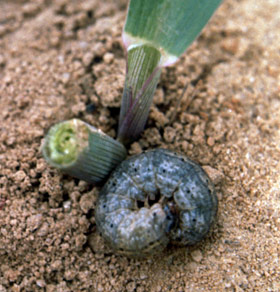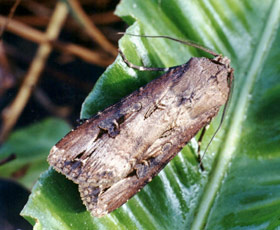Cutworm (Black Cutworm), Agrotis ipsilon

W.M. Hantsbarger, Bugwood.org.
IPM Steps to Reduce Cutworms
1. Sample for Pest
Confirm the presence of cutworms before you treat.
Where to find it while inspecting: You may find black cutworm as the culprit behind small dead spots of thinned or missing turf from June through August. Cutworm adults (moths) and the caterpillars are active at night. The best way to monitor is to use the soapy flush method. Suspicious areas where turf looks to have been broken off at the crown are a sign of caterpillar activity. Close inspection may reveal burrowing near ground level and small green pellets—cutworm frass.
2. Proper ID
Are they cutworms?
Size and Appearance: Cutworms are dull colored moths with a wingspan of ~2". The front wings have distinct patterns of spots (see photos). The caterpillar matures to 2" and are also dark gray, dull with hints of stripes in darker or brown colorings (sometimes greenish tint to striping).
3. Learn the Pest Biology
What is the life cycle of cutworms?
Life Cycle: Adult moths generally do not overwinter in cooler areas of the Northeast and will migrate south in the fall. Adults (whether overwintering or returning) will lay eggs in grass in spring. Caterpillars hatch at 1 mm and begin to feed on grass stems. They grow (molting 6–7 times) for 2–4 weeks until they pupate in the soil. The caterpillar stage (the black cutworm) can do a lot of damage to grass blades and plant stems. Cutworms that attack vegetable gardens are generally hatched from eggs laid in the soil surface.
Preferred Food Sources: Larvae (cutworm) turfgrass leaves and stems; adults feed on flowers and are not considered a pest—the larvae are a pest of turfgrass and plant seedlings.
Preferred Habitat: In turf: eggs are attached to turfgrass blades or plant stems. In vegetable gardens: eggs are found in leaf litter. Larvae feed at night.
4. Determine Threshold

Black Cutworm adult. Photo by Ian Kimber, Bugwood.org.
How many cutworms are too many?
Threshold: On very healthy turf, some cutworm damage can be tolerated. On weak turf, cutworm damage and create large areas of dead turf. Thresholds are generally based on aesthetics.
5. Choose Tactics
Creating a healthy soil condition and understanding turfgrass’s needs is the first step in reducing turf pests. What can I do to treat, reduce, or prevent cutworms?
Best Management Practices: Changing turf from your existing mix to that of endophytic varieties will help. (Look for Endophyte-enhanced grass.) Bt is another nonchemical option, but must be done following local regulations and instructions to provide the optimal chances of success (see Bacillus thuringiensis variety kurstaki). Bt is a naturally occurring bacteria which will slowly debilitate caterpillars—not just cutworms, but many other larvae as well. Entomopathogenic nematodes, Steinernema carpocapsae, are naturally occurring microscopic soil worms that invade other soil organisms and infect them with a bacterium which eventually causes death. Nematodes are applied with irrigation and should be done early in the summer season when larvae are most vulnerable. Nematode applications require diligence to moisture levels—they must not be allowed to dry out until they have settled into the soil. Keep the turf wet before, during and after for at least 8–12 hours.
Treatment Methods: For severe infestations, insecticide treatments are available if allowed in your district. Timing is key in success.
6. Evaluate
Was the tactic successful? Record the date pests were first noted, and the tactic you used, and its success. Use one of our RECORD KEEPING tools.
For More Information:
Ohio State University BugDoc: Black Cutworm
UMass Amherst Agriculture and Landscape Program: Cutworms
CCE Suffolk County Horticulture Diagnostic Laboratory: Cutworms
Cornell University Home Gardening Managing Insect Pests in Vegetable Gardens
Remember:
When a pesticide application is necessary, all necessary and required precautions are taken to minimize risk to people and the environment and to minimize risk of pesticide resistance or pest resurgence. Pesticide use in your school may be prohibited or regulated by local policies or state and federal regulations. Risk reduction methods can include, but are not limited to, spot-treatment, the use of gel or paste bait formulations placed in inaccessible locations, injection into a crack or crevice, and other methods that reduce potential exposure.